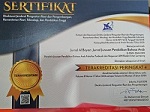Investigation of the Reference Level Description for Arabic Proficiency Tests in Indonesia
Abstract
Keywords
Full Text:
PDFReferences
Abdullah, Mohammad Roshimi, and Mohd Aizul Yaakob. “A Review of Studies Related to Arabic Language Learning Based on the Common European Framework of Reference for Language (CEFR).” Ijaz Arabi Journal of Arabic Learning 6, no. 2 (2023): 463–475.
Abdurrahman, Maman, Syihabuddin, Asep Sopian, Hikmah Maulani, and Ahmad Faqih. “Arabic Language Proficiency Test Efficiency and Innovation on Imalah. com.” Proceedings of the Fifth International Conference on Language, Literature, Culture, and Education (Icollite 2021) 595 (2021): 419–423.
Al-Ababneh, Mukhles. “Linking Ontology, Epistemology and Research Methodology.” Science and Philosophy 8, no. 1 (2020): 75–91.
Baso, Yusring Sanusi, Nurul Murtadho, Syihabuddin, Hikmah Maulani, Andi Agussalim, Haeruddin, Ahmad Fadlan, and Ilham Ramadhan. “Reducing Cheating in Online Exams Through the Proctor Test Model.” International Journal of Advanced Computer Science and Applications 14, no. 1 (2023): 366–371.
Berger, Armin. “Specifying Progression in Academic Speaking: A Keyword Analysis of CEFR-Based Proficiency Descriptors.” Language Assessment Quarterly 17, no. 1 (2020): 85–99.
Boeren, Ellen. “Understanding Sustainable Development Goal (SDG) 4 on ‘Quality Education’ from Micro, Meso and Macro Perspectives.” International Review of Education 65 (2019): 277–294.
Breuker, Mark. “CEFR Labelling and Assessment Services.” European Language Grid: A Language Technology Platform for Multilingual Europe. Cham: Springer International Publishing (2023): 277–282.
Filipovic, Jelena. “Transdisciplinary Qualitative Paradigm in Applied Linguistics: Autoethnography, Participatory Action Research and Minority Language Teaching and Learning.” International Journal of Qualitative Studies in Education 32, no. 5 (2019): 493–509.
Foley, Joseph. “CLT Using CEFR and EIL in Southeast Asia and East Asia in the English Language Classroom.” RELC Journal 53, no. 1 (2022): 240–252.
Franz, Jens, and Adisa Teo. “‘A2 Is Normal’ – Thai Secondary School English Teachers’ Encounters with the CEFR.” RELC Journal 49, no. 3 (2018): 322–338.
Jaekel, Nils, Michael Schurig, Isabelle van Ackern, and Markus Ritter. “The Impact of Early Foreign Language Learning on Language Proficiency Development from Middle to High School.” System 106 (2022): 102763.
Laborda, Jesus Garcia, and Miguel Fernandez Alvarez. “Multilevel Language Tests: Walking into the Land of the Unexplored.” Language Learning and Technology 25, no. 2 (2021): 1–25.
Maulani, Hikmah, and Ahmad Faqih. “Learning Arabic for Beginners: Role-Based Small Group Discussion Cooperative Learning.” Tanwir Arabiyyah: Arabic as Foreign Language Journal 1, no. 2 (2021): 83–92.
Morgan, Hani. “Conducting a Qualitative Document Analysis.” Qualitative Report 27, no. 1 (2022): 64–77.
Musthofa, Tulus. “CEFR-Based Policy in Arabic Language Teaching and Cultural Dimension in Indonesian Islamic Higher Education.” Eurasian Journal of Applied Linguistics 8, no. 2 (2022): 96–107.
Nagai, Noriko, Gregory C Birch, Jack V Bower, and Maria Gabriela Schmidt. The CEFR and Practical Resources. Singapore: Springer Singapore. 2020.
Novawan, Adriadi, Susan Mila P. Alvares Tosalem, Suyik Binarkaheni, and Evi Risa Mariana. “Reflecting on the Common European Framework of Reference for Languages: Learning, Teaching, and Assessment (CEFR) in the Indonesian Context.” Journal of English in Academic and Professional Communication 9, no. 1 (2023): 1–10.
Nur, Mugi Rahayu, Nunung Nursyamsiah, and Hikmah Maulani. “Analysis of Difficulties in Learning Tathbiq Hiwar at Senior High School.” Jurnal Sinestesia 13, no. 1 (2023): 547–556.
Pintard, Alice, and Thomas François. “Combining Expert Knowledge with Frequency Information to Infer CEFR Levels for Words.” Proceedings of the 1st Workshop on Tools and Resources to Empower People with Reading Difficulties, no. May (2020): 85–92.
Rakhlin, Natalia V., Abdullah Aljughaiman, and Elena L. Grigorenko. “Assessing Language Development in Arabic: The Arabic Language: Evaluation of Function (ALEF).” Applied Neuropsychology: Child 10, no. 1 (2021): 37–52.
Sufi, Mohd. Khairul Abu, and Mahani Stapa. “Should the CEFR Illustrative Scales Be Localised to Malaysian Higher Education Standards?–A Conceptual Paper.” International Journal of Academic Research in Business and Social Sciences 10, no. 9 (2020): 885–897.
Tergujeff, Elina. “Second Language Comprehensibility and Accentedness across Oral Proficiency Levels: A Comparison of Two L1s.” System 100 (2021): 102567.
Ulla, Mark B., Junifer L. Bucol, and Pongsathorn Dechatiwongse Na Ayuthaya. “English Language Curriculum Reform Strategies: The Impact of EMI on Students’ Language Proficiency.” Ampersand 9 (2022): 100101.
Waluyo, Budi, Ali Zahabi, and Luksika Ruangsung. “Language Assessment at a Thai University: A CEFR-Based Test of English Proficiency Development.” Language 31, no. 1 (2024): 25–47.
Wang, Hui, Jennifer Lynn Schultz, and Ziyuan Huang. “English Language Proficiency, Prior Knowledge, and Student Success in an International Chinese Accounting Program.” Heliyon 9, no. 8 (2023): e18596.
DOI: http://dx.doi.org/10.24042/albayan.v16i1.21566
Refbacks
- There are currently no refbacks.
Copyright (c) 2024 Jurnal Al Bayan: Jurnal Jurusan Pendidikan Bahasa Arab
License URL: https://creativecommons.org/licenses/by-nc-sa/4.0
Editorial Office:
Jurnal Al Bayan: Jurnal Jurusan Pendidikan Bahasa Arab, Arabic Education Study Program, Faculty of Education and Teachers Training, Unversitas Islam Negeri Raden Intan Lampung
Jl. Endro Suratmin 1 Sukarame, Bandar Lampung 35131-Indonesia
e-mail: jurnalalbayan@radenintan.ac.id
http://ejournal.radenintan.ac.id/index.php/albayan/index
Jurnal Al Bayan: Jurnal Jurusan Pendidikan Bahasa Arab is licensed under a Creative Commons Attribution-ShareAlike 4.0 International License. p-ISSN 2086-9282 | e-ISSN 2549-1229









